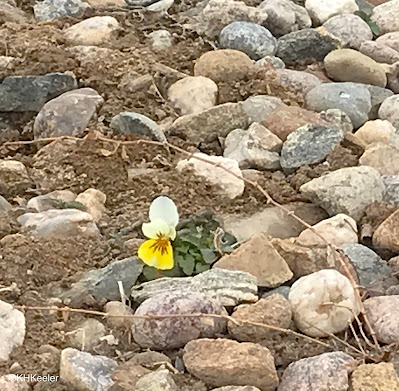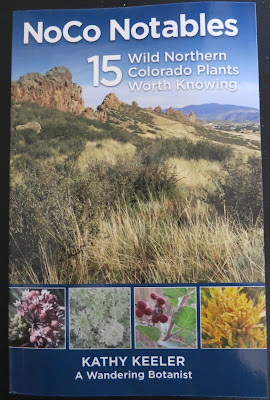I started writing this blog at the beginning of February, 2013. I didn't know how much fun it would be. I still haven't missed a week, although I have given myself permission to do so. This last year has been quite different from previous years, since, due to covid, I have not traveled more than 50 miles, which dramatically reduced my exposure to novel experiences to marvel at and write about. But I haven't found any shortage of topics.
 |
| In February 2013, I visited the Big Island of Hawaii: this is looking south and west to the Kona Coast |
I made a video of earliest spring flowers I have seen in other springs, which I posted on Youtube last week link. It's a "watch for these!" list.
Then, walking the neighborhood. I saw three little violets in flower. My video doesn't mention violets as early spring flowers. The first two were in a group of ice pansies that I watch every year (see post about them link). They're in a graveled bed and bounce back quickly as it warms. I don't know why I didn't think of violets or pansies for the video.
Here are the pansy photos from 1 February. This first one may have flowered a week ago and the flower was killed by the most recent snowstorm, or perhaps the bud was frost-damaged but opened anyway. You can see the leaves are green.
.
I believe these to be ice pansies, also called an icicle pansies. They are particularly cold-tolerant pansies. But the identification has turned out to be confused. What we call violets and pansies are different groups (sections) of the genus Viola, which has at least 500 species. I thought they were Viola hiemalis, but that does not seem to be a valid scientific name. Nursery websites promote ice pansies for the northern United States and for Canada, but rarely commit to any scientific name. In addition to being called V. hiemalis (hiemalis means winter in Latin) sometimes they are called Viola wittrockiana var. hiemalis. Viola wittrockiana is the hybrid that became our garden pansy. Sometimes they are Viola tricolor var. hiemalis; Viola tricolor is a European violet that long ago became a garden flower. It is a puzzle because I cannot find Viola hiemalis listed even as an alternate name (synonym) of some real plant in the scientific literature. Very odd.
This purple violet was mostly under the shrub, blooming on 2/1/21, several blocks from the previous two flowers. It was almost certainly newly opened, despite it being February.
Like many people, I watch carefully for signs of spring. Snowdrops are also called Candlemas flowers and Candlemas is February 2, so as February nears, I carefully watch for my snowdrops to flower. In my yard, I haven't seen them flower before mid-February. This year too, they were not up at all at Candlemas. (link)
So a botanist doesn't need to travel the world, the backyard and neighborhood are full of plants worth observing.
And, alas, all the issues of the wide world are close to home too. My yard's climate is warming, air and light pollution degrade the habitat, plants native to where I live are in danger of extinction--and certainly can't be found on my street any more--it goes on. It is not just other people's butterflies and song birds that are much fewer than 30 years ago. I can watch, listen, learn, and try to be part of making the world better.
So I look forward to whatever adventures this year brings, far across the globe or behind my house.
This week, I'm celebrating writing a blog a week for 8 years, and looking forward to more. Thank you for reading!
Comments and corrections welcome, as always.
Reference
Hodgson, L. 2017. 2017:The Year of the Pansy. The Laidback Gardenerer Blog. link Accessed 2/4/21. Includes how to tell tell the Viola species called pansies from Viola species called violets.
If you are planning to hike the Colorado Front Range this spring, I have a book, NoCo Notables, which describes the biology and history of 15 on the most visible plants. It is available on Amazon link (or contact me).
Look Twice describes the natural history and folklore of the 15 of the most conspicuous plants in western Nebraska, eastern Colorado, an area which has not received much attention. Also on Amazon link
Kathy Keeler, A Wandering Botanist
More at awanderingbotanist.com
Join me on Facebook: https://www.facebook.com/AWanderingBotanist
More at awanderingbotanist.com
Join me on Facebook: https://www.facebook.com/AWanderingBotanist





Congratulations on your longevity. I haven't commented frequently, but I always read and enjoy your posts. Carry on!
ReplyDelete